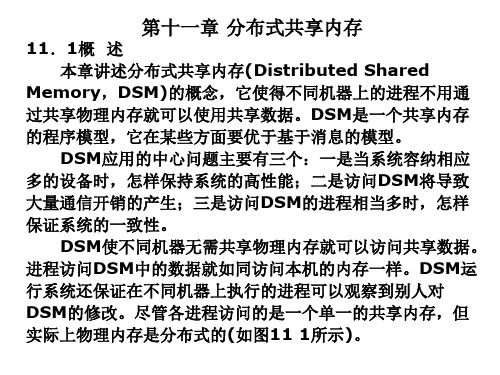第七章分布式共享内存系统及程序设计
第十一章分布式共享内存

11.2.6 抖动问题 写无效协义的一个潜在问韪就是抖动问题。抖 动指的是数据无效的时间超出了等待访问它的进程 的有效工作时间。例如,如果一个进程读的是一个 被另一进程反复修改的数据项,那么该数据项对读 进程而言总是无效的。
2.弱一致性 弱一致性模型可以避免有序一致性模型的通信开销。这个模型用同步模型 的知识来解决内存一致性问题,而程序看上去是在有序一致性模型下运行。例 如,如果一个程序的某一段是临界段,它就给这一段操作的数据加上锁,其他 进程由于互斥性不能访问这些加锁数据,DSM系统在进程离开临界段并解除 了锁以后,将这些修改传送给备份管理者。虽然在加锁期间,这些数据是不一 致的,但由于其他进程访问不到它,因而整个过程看上去就像是有序一致的。 一个DSM系统在一个同步模型下是弱排序的,当且仅当遵循同步模型规 则的所有软件在运行中表现出有序一致性。 11.2.4 修改问题 将一个进程所作的修改传送给其他进程时,有两种选择:写有效和写无效。 它们适用于不同的一致性模型,包括有序一致性模型。 1.写有效 当一个进程在本地修改了一个数据项时,它将修改值传送给拥有该数据项 的备份管理者,其他进程要从本地读出这个修改值来替代原来的值。为了允许 有多个读进程存在,有些进程可以在同一时刻修改同一数据项,这就是所谓多 个读者多个写者的共享。 能使用写有效方式的一致性模型要满足几个条件,首要条件是修改传送 (也称为组播)的顺序要合适。有序一致性要求采用完全有序组播,这一组播直 到修改消息被传送回来才算结束。所有进程都遵循这一修改的顺序,保证了整 个DSM的有序一致性。
11.2.2 同步模型 在DSM中,常常在某些变量之间建立一种约束,例如,a=b就是一 种约束,但这种约束并不稳定,如果两个或多个进程执行下列代 码:a=a+1;b=b+1;就会产生不一致性。假设a、b初值都为0,当进 程1将a置为1,在置b为1之前,进程2开始执行,它将a置为2,b置为 1,这时,约束条件被打破。解决这一问题的方法是将这段代码设计成临 界段。 为了使用DSM,必须有一个分布式同步服务保证DSM的同步性, 它包括我们熟悉的加锁和信号量。目前大多数DSM应用都利用同步模型 来减少修改值传送的数量,包含同步模型的DSM才能称为一个完整的 DSM。 11.2.3 一致性模型 DSM实现使用缓存来提高效率,在大多数情况下,为了保证效率, 数据是从本地缓存中取出的,但出现修改时,就要将这一改变传给其他 备份管理者。 除了缓存外,DSM实现可以采用写缓冲访问,它可以 减少因写操作而产生的通信开销。采用这些缓冲技术时,能否保证DSM 内存的一致性仍是-一个值得注意的问题,这种一致性称为内存一致性。 在实践中应用的DSM的一致性模型主要可分为有序一致性模型和弱 一致性模型。
分布式系统中的数据共享与访问控制

分布式系统中的数据共享与访问控制随着信息技术的不断发展,分布式系统在各个领域得到了广泛应用。
在分布式系统中,数据的共享与访问控制是一项重要的任务,它直接关系到系统的可靠性和安全性。
本文将对分布式系统中的数据共享和访问控制进行讨论,并介绍一些常见的解决方案。
一、数据共享在分布式系统中,数据共享是指多个节点可以同时访问和修改同一份数据。
数据共享可以提高系统的性能和效率,同时也增加了系统的复杂性和风险。
1. 数据共享模型常见的数据共享模型包括:共享内存模型、消息传递模型和数据库模型。
- 共享内存模型:多个节点通过共享的内存空间来进行数据交换。
这种模型的优点是数据访问高效,但是需要考虑数据一致性和并发控制的问题。
- 消息传递模型:通过消息传递的方式进行数据交换。
每个节点有自己的一份数据拷贝,通过互相发送消息来实现数据共享。
这种模型可以提高系统的灵活性,但是增加了通信开销。
- 数据库模型:数据存储在共享数据库中,多个节点可以通过数据库接口进行数据访问。
数据库管理系统负责处理并发访问和一致性问题。
这种模型适用于需要频繁进行数据读写的场景。
2. 数据一致性数据一致性是指在多个节点间共享数据的过程中,所有节点看到的数据是一致的。
在分布式系统中,由于网络延迟和节点故障等原因,数据可能出现不一致的情况。
为了保证数据一致性,可以采用以下方法:- 基于锁机制:通过互斥锁等机制来控制对共享数据的访问。
只有拥有锁的节点才能修改数据,其他节点需要等待。
- 基于事务:将一系列对数据的访问操作封装为事务,并通过提交(commit)和回滚(rollback)操作来保证数据的一致性。
- 基于副本技术:将数据复制到多个节点上,通过副本一致性协议来保证数据的一致性。
二、访问控制在分布式系统中,为了保证数据的安全性和隐私性,需要对数据的访问进行控制。
访问控制是指根据用户的身份和权限来限制其对数据的访问操作。
1. 访问控制模型常见的访问控制模型有:基于角色的访问控制(RBAC)、强制访问控制(MAC)和自主访问控制(DAC)。
多处理机系统中的调度教案

多处理器调度算法(14)
4)动态调度算法(1)
• 基本思想:由操作系统和应用进程共 同完成调度。
• 操作系统负责在应用进程之间划分处 理器。
• 应用进程在分配给它的处理器上执行 可运行线程的子集,哪一些线程应该 执行,哪一些线程应该挂起完全是应 用进程自己的事。
多处理器调度算法(6)
自调度算法不足
• 就绪线程队列将成为性能的瓶颈。
• 被抢占的线程很难在同一个处理 器上恢复运行,会带来性能下降。
• 线程都被放在公共线程池中,所 有线程获得处理器的机会相同。 如果一个程序的线程希望获得较 高优先级,进程切换将导致性能 的折衷。
多处理器调度算法(7)
2)群组调度算法
多处理器调度算法(4)
自调度算法优点
• 把负载均分到所有可用处理器上,保
证了处理器效率的提高。
• 不需要集中的调度程序,一旦一个处
理器空闲,调度程序就可以运行在该 处理器上以选择下一个运行的线程。
• 运行线程的选择可以采用各种可行的
策略。
多处理器调度算法(5)
自调度算法
(1)先来先服务。 (2)最少线程数优先。 (3)有剥夺的最少线程数优先。
个有4个线程,另一个有1个线程。 若使用统一的时间分配,每个应 用程序可获得50%的CPU时间, 由于后一个线程运行时,有三个 处理器是空闲的,于是浪费的 CPU资源为37.5%。
多处理器调度算法(11)
• 可选择的另种统一时间分配称线 程数加权调度法,具体来说,给 第一个应用程序分4/5CPU时间, 给第二个应用程序分1/5的时间, 则处理器时间浪费可降到15%。
《高性能并行运行时系统:设计与实现》随笔

《高性能并行运行时系统:设计与实现》读书随笔目录一、内容综述 (2)1.1 背景与动机 (3)1.2 高性能并行运行时系统的意义 (3)二、并行运行时系统的基本概念 (4)2.1 并行计算与并行运行时系统 (6)2.2 并行运行时系统的组成部分 (7)三、高性能并行运行时系统的设计要素 (9)3.1 性能优化策略 (10)3.2 可扩展性与可维护性 (12)3.3 容错与稳定性 (13)四、典型高性能并行运行时系统分析 (15)4.1 MapReduce及其应用场景 (16)4.2 Spark的工作原理与应用 (17)4.3 分布式内存计算系统TBB (19)五、并行运行时系统的实现技术 (21)5.1 编程模型与语言支持 (22)5.2 数据存储与管理 (24)5.3 网络通信与通信协议 (25)六、高性能并行运行时系统的测试与调试 (27)6.1 测试方法与工具 (28)6.2 常见问题与解决方案 (30)七、总结与展望 (31)7.1 本书主要内容回顾 (32)7.2 对未来发展的展望 (34)一、内容综述《高性能并行运行时系统:设计与实现》是一本关于高性能并行计算的经典著作,作者是著名的计算机科学家和教授。
本书详细介绍了高性能并行运行时系统的设计与实现过程,旨在为读者提供一套完整的理论框架和技术方法,以便在实际项目中构建高效、可扩展的并行计算系统。
本书共分为五个部分,分别是:并行计算基础、并行编程模型、并行数据结构与算法、并行运行时系统设计及实例分析和总结。
在前三部分中,作者首先介绍了并行计算的基本概念、原理和技术,包括共享内存模型、消息传递接口(MPI)等;接着详细讲解了并行编程模型,如任务划分、同步与互斥、负载均衡等;作者还介绍了一些常用的并行数据结构与算法,如哈希表、B树、红黑树等。
在第四部分中,作者深入探讨了并行运行时系统的设计与实现,包括线程管理、进程管理、资源分配等方面。
通过一系列实例分析,作者展示了如何根据具体问题选择合适的并行计算模型和编程技术,以及如何在实际项目中实现高效的并行运行时系统。
《并行程序设计导论》第二章-2024鲜版

科学计算模拟:分享一个科学计算模拟的优化案例,通过并行算法设 计和使用高性能计算资源,加速了模拟过程的执行速度。
2024/3/27
21
05
分布式内存并行程序设计
2024/3/27
22
分布式内存编程模型概述
2024/3/27
分布式内存架构
01
介绍分布式内存架构的基本概念、特点以及与其他并行计算模
了解OpenCL编程模型和异构设备特性,使 用OpenCL C编写跨平台并行代码,调试并 优化程序性能。
2024/3/27
17
04
并行程序性能优化
2024/3/27
18
性能优化策略与方法
任务划分与负载均衡
将计算任务合理划分到不同的处理单元上, 确保各处理单元负载均衡,避免某些处理 单元空闲而其他处理单元过载。
2024/3/27
大规模并行计算
随着大数据时代的到来,处理海量数据需要越来越 强大的计算能力。如何设计和实现能够处理大规模 数据的并行算法和系统,是未来的重要研究方向。
并行计算与人工智能的融合
人工智能技术的快速发展为并行计算提供了新的应 用场景和挑战。如何将并行计算与人工智能技术相 结合,推动人工智能技术的进一步发展,是未来的 重要研究方向之一。
确保编译器支持OpenMP,设置编 译器选项以启用OpenMP,测试 OpenMP程序运行。
2024/3/27
CUDA环境配置
安装CUDA Toolkit,配置GPU驱动, 设置环境变量,测试CUDA程序运行。
OpenCL环境配置
安装OpenCL SDK,配置设备驱动, 设置环境变量,测试OpenCL程序运 行。
图算法
通过图算法的实例,如最短路径、最小生 成树等,讲解分布式内存并行程序在处理 复杂数据结构时的应用。
2024版年度《并行程序设计导论》第四章

•并行计算基础•并行算法设计•并行编程模型与语言目录•并行程序性能优化•并行程序调试与性能分析•总结与展望并行计算概念及特点并行计算概念并行计算是指在同一时间内,使用多个计算资源(如处理器、核心、计算机等)同时执行多个计算任务的过程。
并行计算特点并行计算的主要特点包括同时性、独立性、加速比和可扩展性等。
其中,同时性指多个任务在同一时间内执行;独立性指各个任务之间互不干扰;加速比指并行计算相对于串行计算的加速效果;可扩展性指并行计算系统能够方便地增加计算资源以提高计算能力。
多核处理器集群系统分布式共享内存系统任务并行数据并行流水线并行并行算法特点并行算法分类与特点常见并行算法介绍如并行快速排序、归并排序等,提高排序速度。
如并行广度优先搜索、最短路径算法等,用于图论问题的求解。
如矩阵乘法、矩阵分解等,加速线性代数计算。
如并行蒙特卡洛方法、并行有限元方法等,应用于科学计算领域。
并行排序算法并行图算法并行矩阵运算并行数值计算并行算法性能评价加速比效率可扩展性复杂度分析共享内存编程模型原理及特点常用同步机制典型应用01 02 03原理及特点常用通信方式典型应用消息传递编程模型OpenMP 存并行编程的了简单的并行循环、分段、任务等构造,以及丰富的同步和互斥机制。
用于多核、多线程等共享内存环境,可以方便地实现并行化。
OpenMP MPI 编程的标准接口,提供了丰富的通信函数和同步机制。
MPI 系统等环境,可以实现大规模并行计算。
MPI CUDA 一种并行计算平台和编程模型,支持CUDA 程接口和扩展库,可以方便地实现应用程序。
CUDA 除了上述三种常见的并行编程语言外,还有许多其他语言和工具支持并行编程,如Fortran 这些语言和工具各有特点,可以根据具体应用场景选择合适的编程语言和工具。
其他语言并行编程语言介绍针对特定问题选择合适的并行算法,通过减少计算量、提高计算效率来优化性能。
算法选择与优化数据结构与存储优化编译优化技术运行时优化技术合理设计数据结构,减少数据冗余和访问冲突,提高数据存储和访问效率。
分布式共享存储PPT教案学习

3
分布式共享存储器(DSM)
Li 和Hudak提出让一组由局域网互连的工作 站共享一个分页的虚拟地址空间。
不共享整个地址空间,而只共享其中所选 择的一部分,即那些由多个进程引用的变 量和数据结构。
b=1; c=1; print(a,b); print(a,c); a=1; print(b,c);
b=1; a=1; c=1; print(a,c); print(b,c); print(a,b);
(a)
(b)
(c)
(d)
第28页/共65页
29
因果一致性
按有无可能的因果联系区分各事件,对于因果相关 的写操作,所有进程看到的执行顺序应相同。
≈
≈
(c)
(a)Memnet环 (b)单一主机 (c)块表
第15页/共65页
16
交换式多处理机
CPU增加到一定数量时,总线或环的带宽 达到饱和,再增加额外的CPU也不会提高 系统性能减少通信流量
采用两种方法解决带宽不足的问题
减少通信流量
–
改善缓冲协议,优化块大小,重组程 序,以 提高存 储器访 问的本 地命中 率。
第29页/共65页
30
因果一致性举例
(1)违反因果一致性
P1:W(x)1 P2: P3: P4:
R(x)1 W(x)2
R(x)2 R(x)1
R(x)1 R(x)2
(2)符合因果一致性
P1:W(x)1 P2: P3: P4:
W(x)2
R(x)2 R(x)1 R(x)1 R(x)2
第30页/共65页
并行计算机程序设计导论pdf

CUDA最佳实践
总结CUDA编程的最佳实践, 包括编写高效的CUDA内核函 数、使用异步操作、避免不 必要的内存拷贝等方面的内 容。
43
07
并行计算应用案例分析
BIG DATA EMPOWERS TO CREATE A NEW
ERA
2024/1/25
44
气象模拟应用案例分析
气候模型
使用并行计算模拟大气、海洋和陆地之间的相互作用,以预测气 候变化。
42
CUDA性能优化策略
CUDA性能分析
介绍如何使用CUDA性能分析 工具(如NVIDIA Visual
Profiler和Nsight)来评估和 优化CUDA程序的性能。
CUDA优化技术
详细讲解CUDA优化的关键技 术,包括内存访问优化、线 程同步优化、指令级优化和 算法级优化等。
2024,并行计算的应用前景更加广阔。未来,量子计算等新型计算技术的发展将进一 步推动并行计算的进步,为解决复杂问题提供更加高效的方法。
2024/1/25
6
02
并行计算机体系结构
BIG DATA EMPOWERS TO CREATE A NEW
ERA
2024/1/25
7
并行计算机分类与特点
// 计算点积并汇总结果
03
for (int i = rank; i < n; i += size) {
27
MPI编程实例分析
• dot_product += a[i] * b[i];
2024/1/25
28
MPI编程实例分析
}
// 使用MPI_Reduce函数汇总各个进程的计算结果
2024/1/25
- 1、下载文档前请自行甄别文档内容的完整性,平台不提供额外的编辑、内容补充、找答案等附加服务。
- 2、"仅部分预览"的文档,不可在线预览部分如存在完整性等问题,可反馈申请退款(可完整预览的文档不适用该条件!)。
- 3、如文档侵犯您的权益,请联系客服反馈,我们会尽快为您处理(人工客服工作时间:9:00-18:30)。
Software Page Based DSM Implementation
8
Some Software DSM Systems
9
• Treadmarks
Page based DSM system Apparently not now available
• JIAJIA C based Obtained at UNC-Charlotte but required significant modifications for system (in message-passing calls) • Adsmith object based C++ library routines
Process “join”
20
adsmith_wait();
will cause the process to wait for all its child processes (processes it created) to terminate.
Versions available to wait for specific processes to terminate, using pvm tid to identify processes. Then would need to use the pvm form of adsmith() that returns the tids of child processes.
1பைடு நூலகம்
Distributed Shared Memory
Distributed Shared Memory
2
Making the main memory of a cluster of computers look as though it is a single memory with a single address space.
Software DSM Implementation
7
• Page based - Using the system’s virtual memory • Shared variable approach- Using routines to access shared variables • Object based- Shared data within collection of objects. Access to shared data through object oriented discipline (ideally)
Strict Consistency
11
Every write immediately visible
Disadvantages: number of messages, latency, maybe unnecessary.
Consistency Models used on DSM Systems
Consistency Models
10
• Strict Consistency - Processors sees most recent update, i.e. read returns the most recent wrote to location. • Sequential Consistency - Result of any execution same as an interleaving of individual programs. • Relaxed Consistency- Delay making write visible to reduce messages. • Weak consistency - programmer must use synchronization operations to enforce sequential consistency when necessary. • Release Consistency - programmer must use specific synchronization operators, acquire and release. • Lazy Release Consistency - update only done at time of acquire.
Disadvantages of DSM
5
• May incur a performance penalty • Must provide for protection against simultaneous access to shared data (locks, etc.) • Little programmer control over actual messages being generated • Performance of irregular problems in particular may be difficult
12
Release Consistency
An extension of weak consistency in which the synchronization operations have been specified: • acquire operation - used before a shared variable or variables are to be read. • release operation - used after the shared variable or variables have been altered (written) and allows another process to access to the variable(s) Typically acquire is done with a lock operation and release by an unlock operation (although not necessarily).
17
Adsmith Routines
18
Initialization/Termination
Explicit initialization/termination of Adsmith not necessary.
Process
19
To start a new process or processes:
Access to shared data (objects)
21
Adsmith uses “release consistency.” Programmer explicitly needs to control competing read/write access from different processes. Three types of access in Adsmith, differentiated by the use of the shared data: • Ordinary Accesses - For regular assignment statements accessing shared variables. • Synchronization Accesses - Competing accesses used for synchronization purposes. • Non-Synchronization Accesses - Competing accesses, not used for synchronization.
adsm_spawn(filename, count)
Example
adsm_spawn(“prog1”,10);
starts 10 copies of prog1 (10 processes). Must use Adsmith routine to start a new process. Also version of adsm_spawn() with similar parameters to pvm_spawn().
Synchronization accesses
23
To control competing accesses: • Semaphores
• Mutex’s (Mutual exclusion variables)
• Barriers.
available. All require an identifier to be specified as all three class instances are shared between processes.
• Built on top of pvm
• Freely available - installed on UNCC cluster
User writes application programs in C or C++ and calls Adsmith routines for creation of shared data and control of its access.
Then can use shared memory programming techniques.
DSM System
3
Still need messages or mechanisms to get data to processor, but these are hidden from the programmer:
Release Consistency
13
Lazy Release Consistency
14
Advantages: Fewer messages
15
Adsmith
Adsmith
16
• User-level libraries that create distributed shared memory system on a cluster. • Object based DSM - memory seen as a collection of objects that can be shared among processes on different processors. • Written in C++
